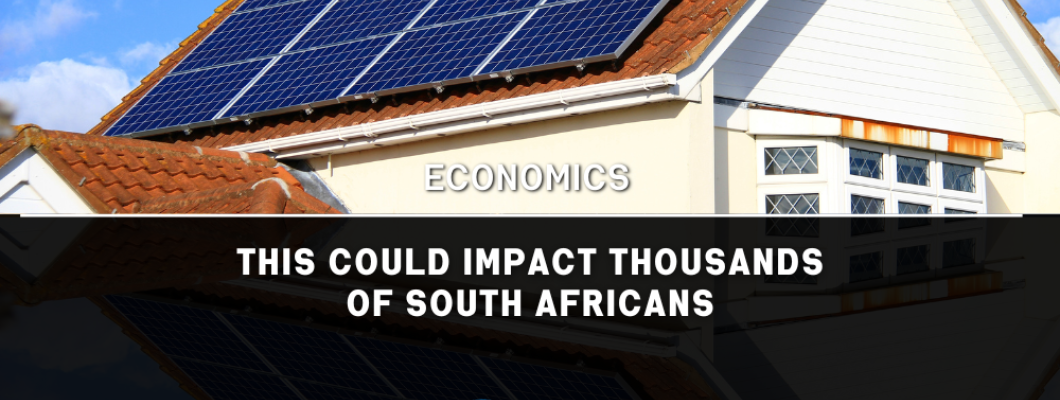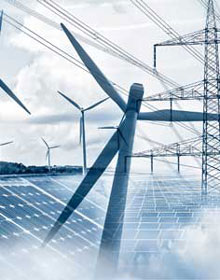
In a move that could impact thousands of South African households, the government is considering imposing a surcharge on residential rooftop solar systems. This decision aims to address revenue shortfalls faced by municipalities that rely on electricity sales. The announcement was made by Minister of Cooperative Governance and Traditional Affairs, Velenkosini Hlabisa, in response to parliamentary questions from ANC MP Nombiselo Sompa-Masiu.
Sompa-Masiu's inquiry focused on how the Department of Cooperative Governance and Traditional Affairs (CoGTA) plans to mitigate the loss of municipal revenue as more households generate their own electricity. Minister Hlabisa acknowledged the challenge posed by off-grid generation and emphasized the need for strategies to diversify and enhance municipal revenue streams.
“To address this, we’re developing strategies to diversify and enhance municipal revenue streams,” stated Hlabisa. Short-term interventions include exploring alternative revenue sources and reviewing tariffs to ensure competitiveness, improve revenue collection, and reduce debt.
Hlabisa revealed that municipalities, under the guidance of the National Energy Regulator of South Africa (Nersa), will impose a surcharge on all scaled-embedded electricity systems. This measure aims to improve revenue generation for municipalities.
“The department, through the office of the Results Management Office (RMO), also supports municipalities in developing their Small-Scale Embedded Generation (SSEG) policies and guidelines,” Hlabisa added. Collaborations with Sustainable Energy Africa are underway to design suitable tariffs for SSEGs and Independent Power Producers (IPPs) seeking to wheel power through municipal networks, thereby enhancing municipal revenues.

Eskom, the state-owned power utility, has also expressed concerns about solar users’ reliance on the national power grid, often referred to as the "Eskom Battery." This occurs when solar generation is insufficient, such as on cloudy days or during peak hours. Consequently, Eskom has proposed structural changes to its retail tariffs, aiming to charge solar users who remain connected to the grid.
“Customers with solar rooftop PV connected to the grid who use Eskom-supplied energy as a backup will still be required to pay for using the Eskom network,” Eskom stated. The proposed changes include introducing a single energy charge, an ancillary network charge, a network demand charge, and a service and administration charge, which would apply irrespective of usage.
If approved, these changes could significantly increase electricity costs for households with grid-tied rooftop solar installations and low-consumption residents. For instance, customers currently paying R196 in fixed fees, even when consuming no Eskom-provided electricity, would see this cost rise by 183% to R554 under the new proposal.
Households consuming around 400kWh per month currently face costs of approximately R1,178, which would increase by 25% to R1,476. Conversely, heavy power users might benefit from these changes, as their monthly bills could decrease. For example, those consuming 900kWh per month would see their costs drop by around 8%, from R2,853 to R2,629.
The proposed changes also include removing the inclining block tariff, which Eskom claims will make electricity more affordable and expand access to electricity services. Additionally, the utility plans to allow solar system owners to sell excess electricity back to the grid to offset their monthly bills. However, the current structure of these arrangements poses challenges for feed-in customers, who struggle to break even on the monthly transmission network charge based on their inverter’s capacity.
As the debate continues, South African residents with rooftop solar systems face uncertainty about future costs and the overall impact on their energy savings. Both municipal and national authorities will need to carefully balance revenue generation with the promotion of sustainable energy solutions. The outcome of these discussions will be crucial in shaping the future of energy consumption and distribution in South Africa.
Credit: Mybroadband


8 Comment(s)
Trò chơi trên FB88 rất đa dạng, tôi luôn tìm thấy trò chơi mình yêu thích.
FB88 luôn cung cấp các sản phẩm game chất lượng cao và dịch vụ khách hàng tốt.
Chất lượng hình ảnh và âm thanh của trò chơi trên FB88 rất tốt, tôi rất thích.
LG VINA COSMETICS CO., LTD., established in 1997, takes pride in bringing renowned cosmetic brands and premium home and personal care brands to Vietnamese customers. We currently operate in two main categories: Beauty and HDB (Home Care and Daily Beauty). The Beauty category includes products from skincare, cosmetics, and functional food groups, while the HDB category covers products in home care and daily personal care groups. With a vision to become a leading company in the beauty and health industry, we are meticulous at every stage of management to ensure that our products are of the highest quality and meet customer needs.
LiveBet là một nền tảng giải trí trực tuyến sáng tạo, cung cấp cược thể thao trực tiếp và nhiều tính năng tương tác. Dù bạn là fan của bóng đá, bóng rổ hay các giải đấu eSports, LiveBet đều mang đến cho bạn trải nghiệm cược hấp dẫn. Với hệ thống cập nhật tỷ lệ cược nhanh chóng, bạn có thể cược trong suốt trận đấu và tận dụng mọi cơ hội chiến thắng. Các phương thức thanh toán an toàn và dịch vụ khách hàng 24/7 đảm bảo bạn chơi mà không lo lắng. Tham gia LiveBet ngay hôm nay để trải nghiệm cược trực tuyến tiên tiến nhất!
FB88 cung cấp một nền tảng rất dễ sử dụng, tôi chưa bao giờ gặp vấn đề với giao diện.
FB88 có nhiều loại game phong phú, đáp ứng nhu cầu của mọi người chơi.
Trò chơi trên FB88 rất dễ chơi, quy tắc rõ ràng và dễ hiểu.
LiveBet là một nền tảng giải trí trực tuyến sáng tạo, cung cấp cược thể thao trực tiếp và nhiều tính năng tương tác. Dù bạn là fan của bóng đá, bóng rổ hay các giải đấu eSports, LiveBet đều mang đến cho bạn trải nghiệm cược hấp dẫn. Với hệ thống cập nhật tỷ lệ cược nhanh chóng, bạn có thể cược trong suốt trận đấu và tận dụng mọi cơ hội chiến thắng. Các phương thức thanh toán an toàn và dịch vụ khách hàng 24/7 đảm bảo bạn chơi mà không lo lắng. Tham gia LiveBet ngay hôm nay để trải nghiệm cược trực tuyến tiên tiến nhất!
Trường Tiểu học Nguyễn Trung Trực được thành lập năm 1985 có địa chỉ tại 9A Phạm Hồng Thái, phường Nguyễn Trung Trực, quận Ba Đình, Hà Nội (Nay thành phường Trúc Bạch). Trường hoạt động dưới sự quản lý của UBND quận Ba Đình và Phòng Giáo dục và Đào tạo Ba Đình. Trường được xây dựng khang trang trên diện tích hơn 3000 m2 với đủ các phòng học và phòng chức năng cho các hoạt động học tập, vui chơi, giải trí của học sinh.
Địa chỉ: Số 9A Phạm Hồng Thái - Ba Đình - Hà Nội
Email: s666@s666s666s.com
website: Https://s666s666s.com/
Điện thoại: 438261441
Trường Tiểu học Nguyễn Trung Trực được thành lập năm 1985 có địa chỉ tại 9A Phạm Hồng Thái, phường Nguyễn Trung Trực, quận Ba Đình, Hà Nội (Nay thành phường Trúc Bạch). Trường hoạt động dưới sự quản lý của UBND quận Ba Đình và Phòng Giáo dục và Đào tạo Ba Đình. Trường được xây dựng khang trang trên diện tích hơn 3000 m2 với đủ các phòng học và phòng chức năng cho các hoạt động học tập, vui chơi, giải trí của học sinh.
Địa chỉ: Số 9A Phạm Hồng Thái - Ba Đình - Hà Nội
Email: s666@s666s666s.com
website: Https://s666s666s.com/
Điện thoại: 438261441
One of the best posts I’ve read. It helped me see the topic differently.
Leave a Comment